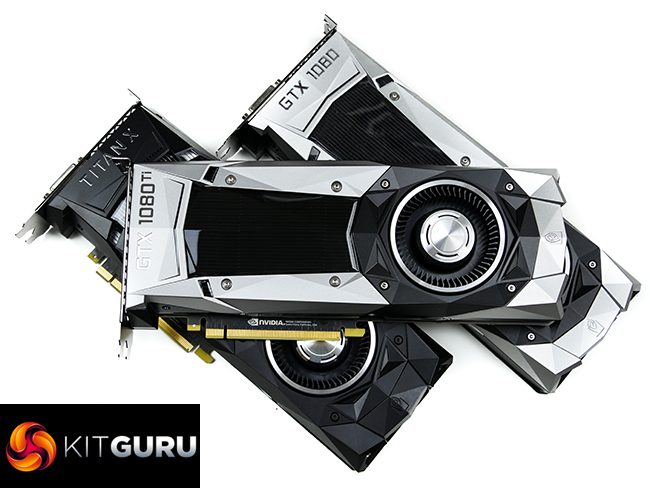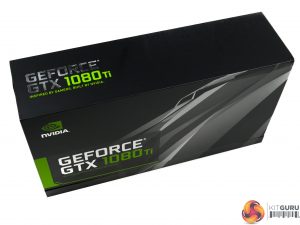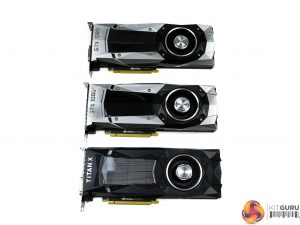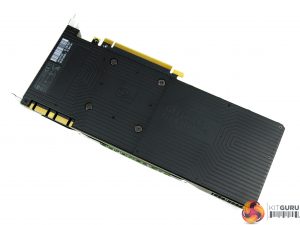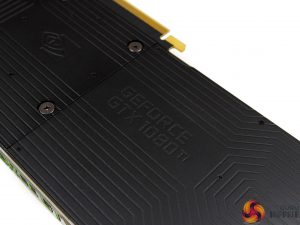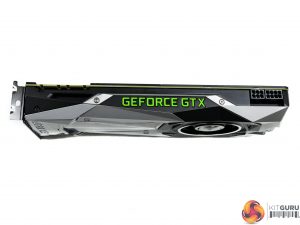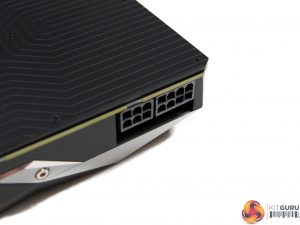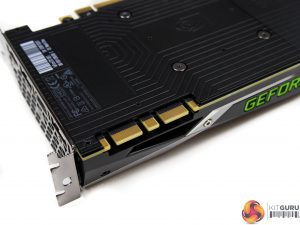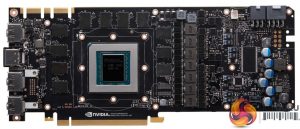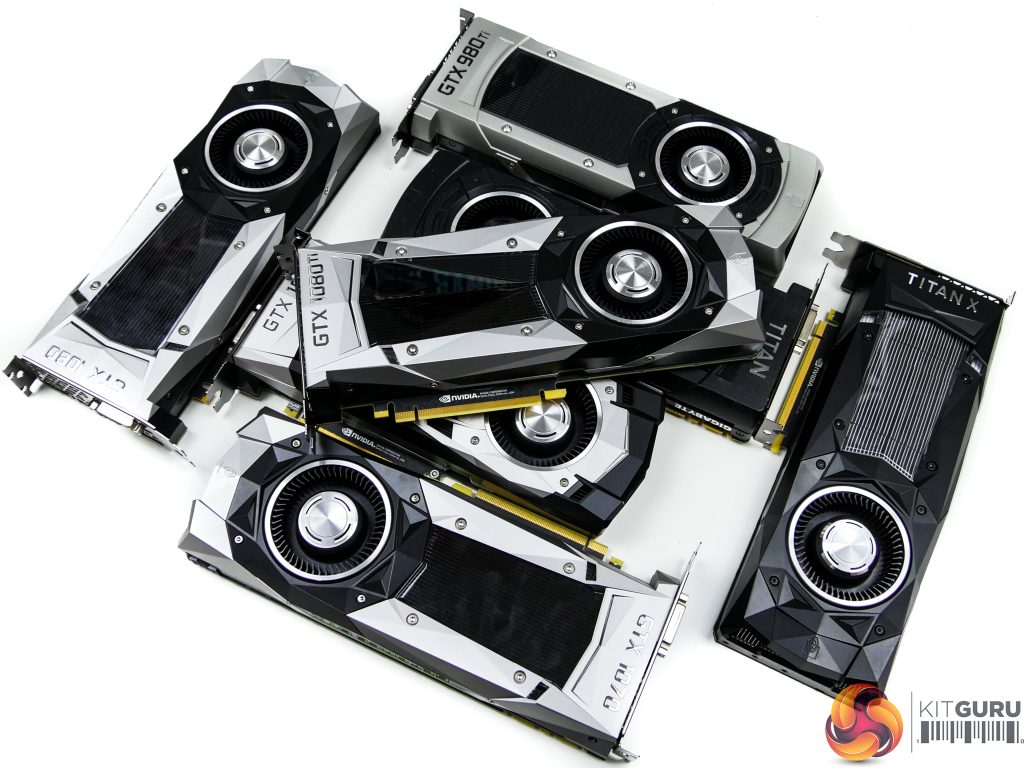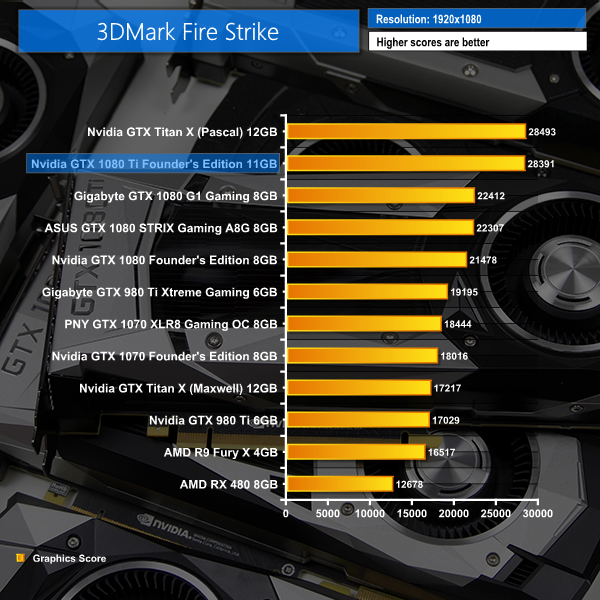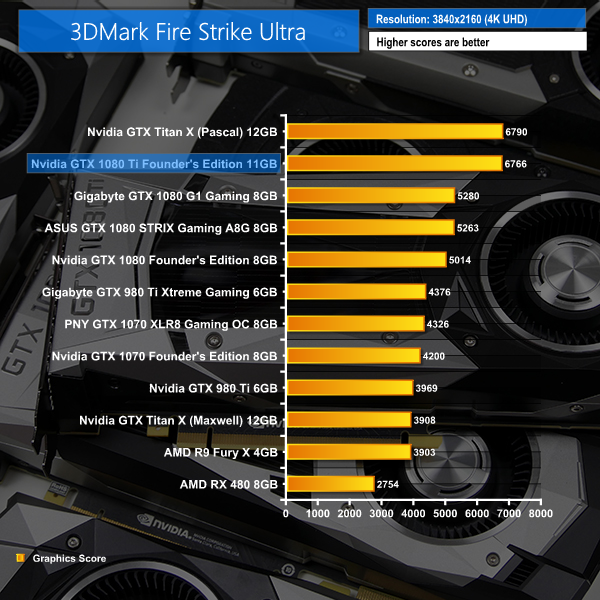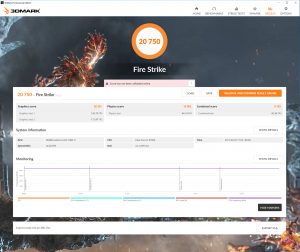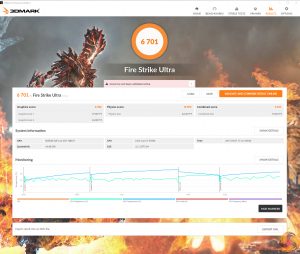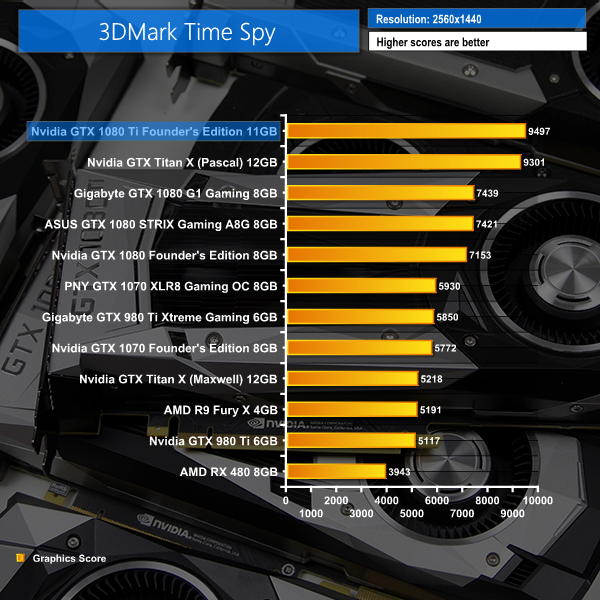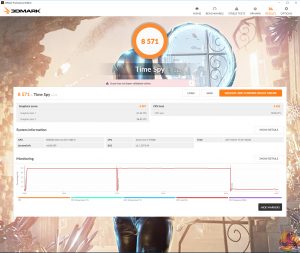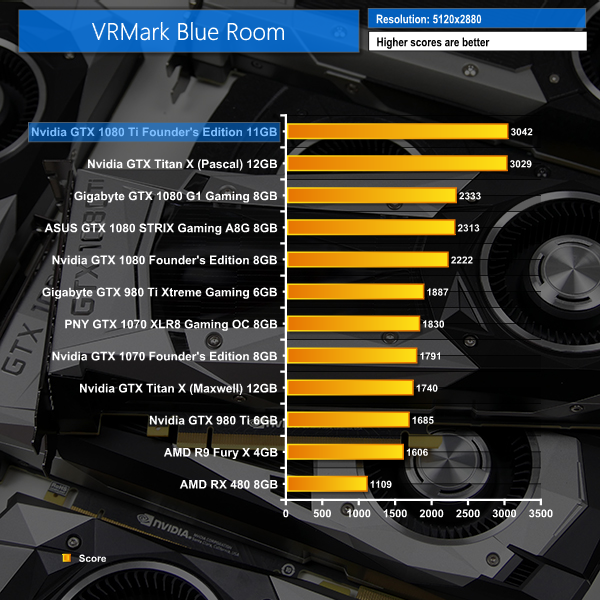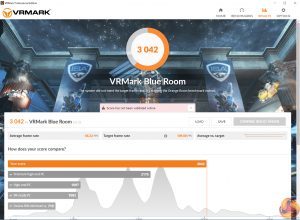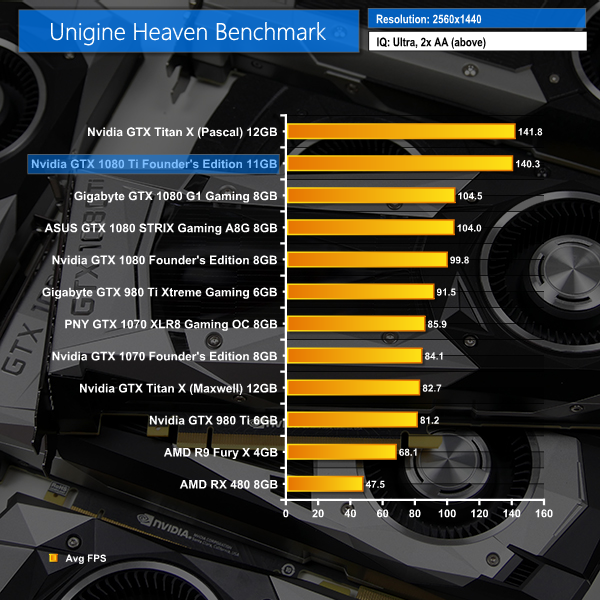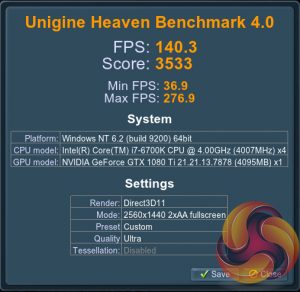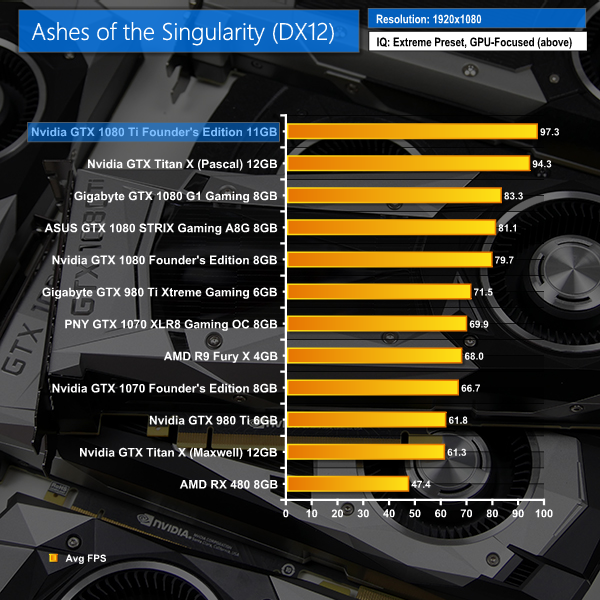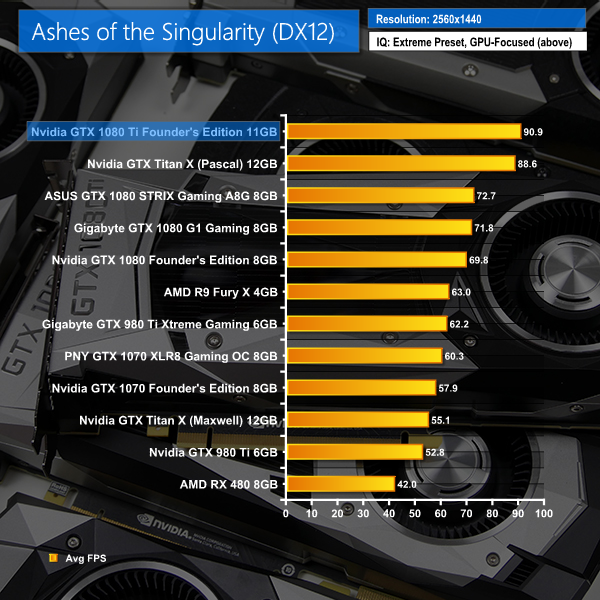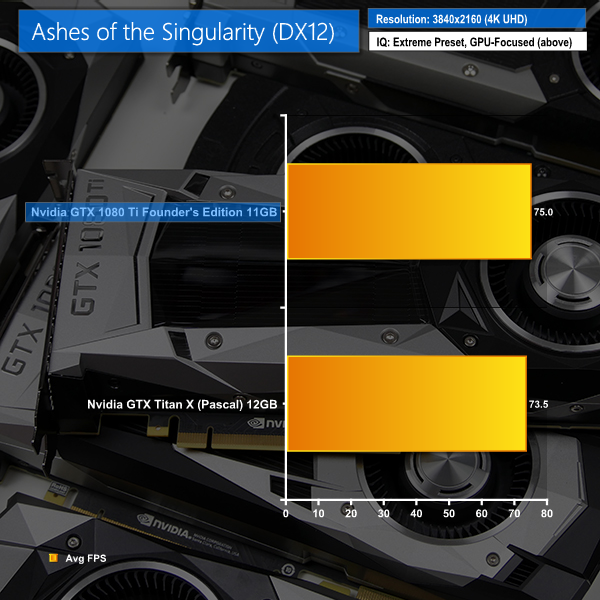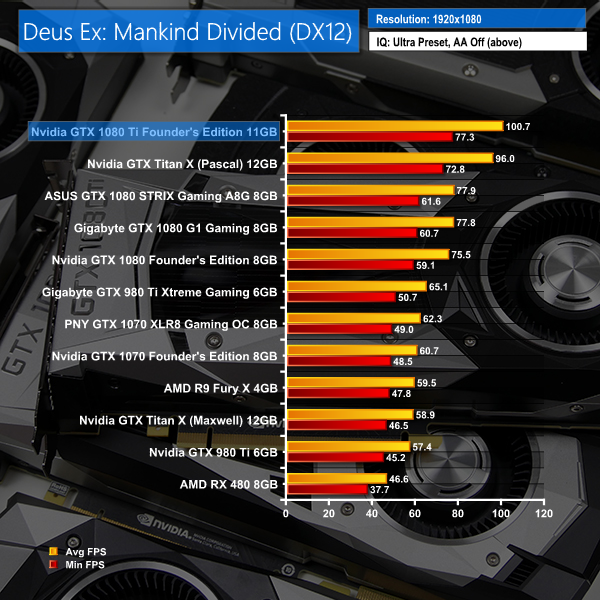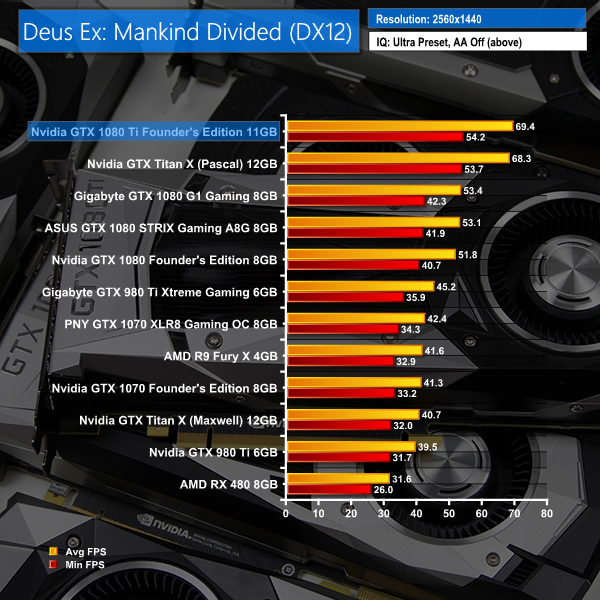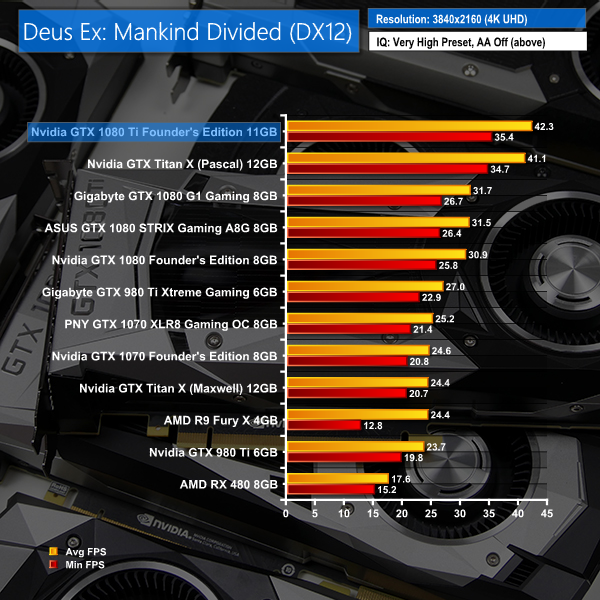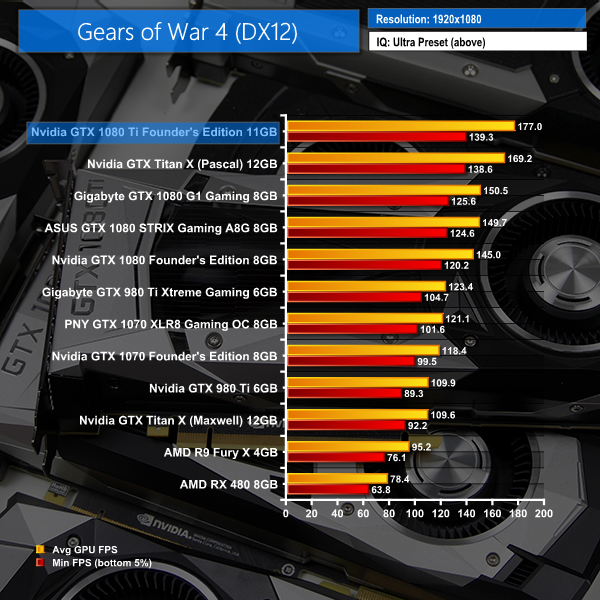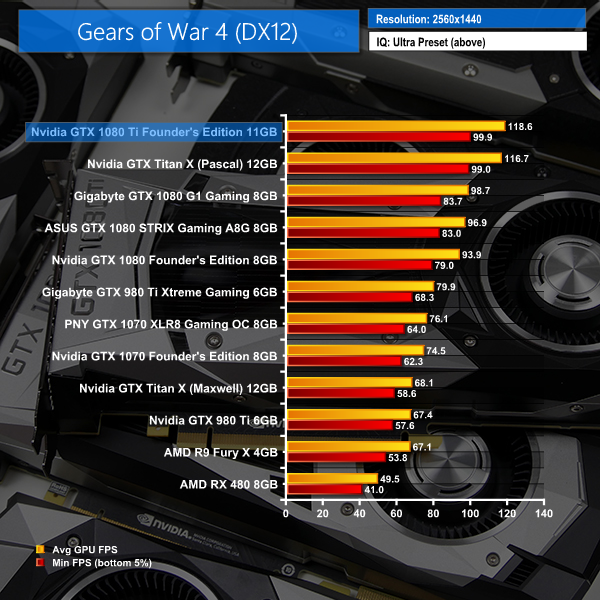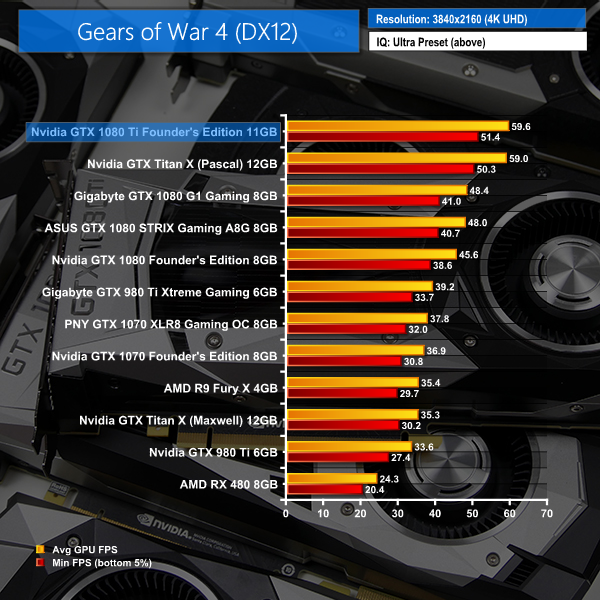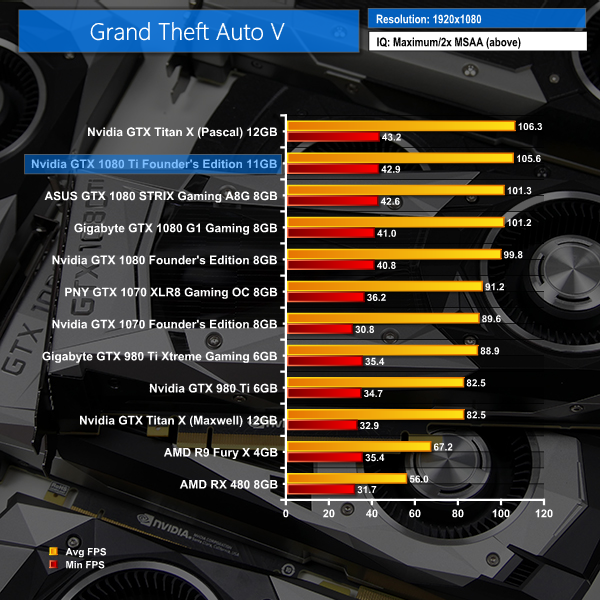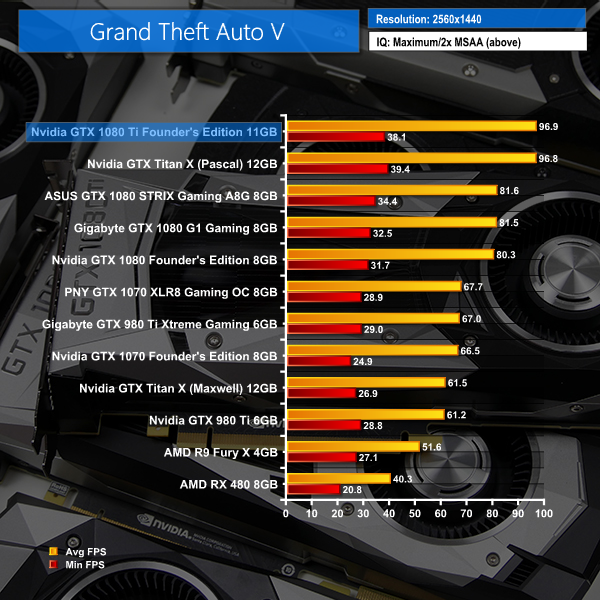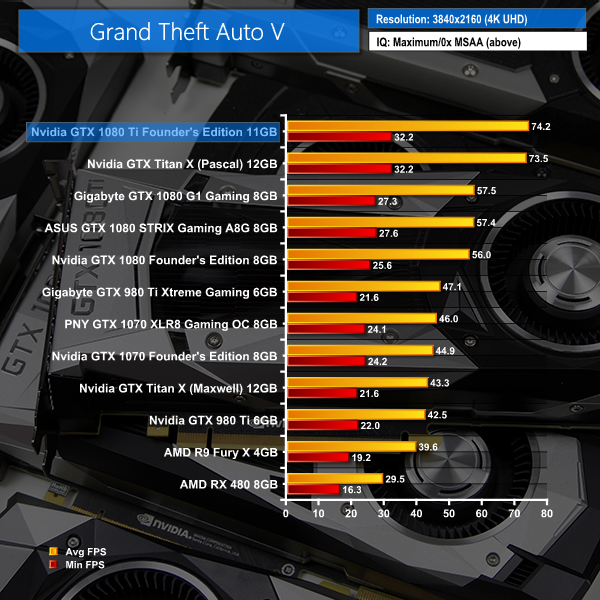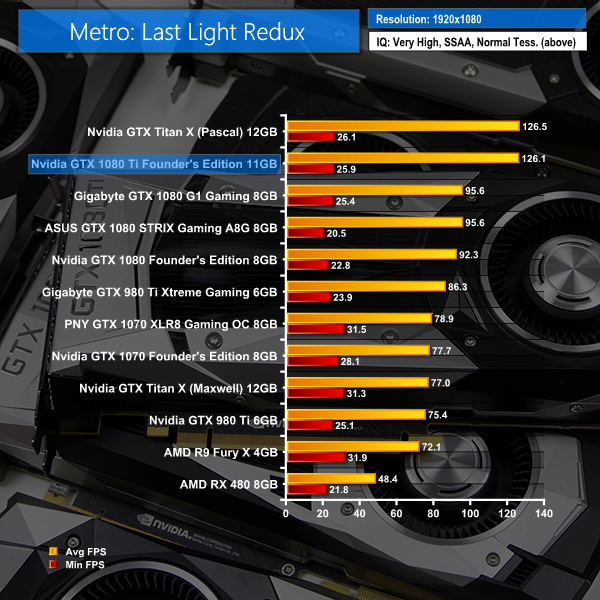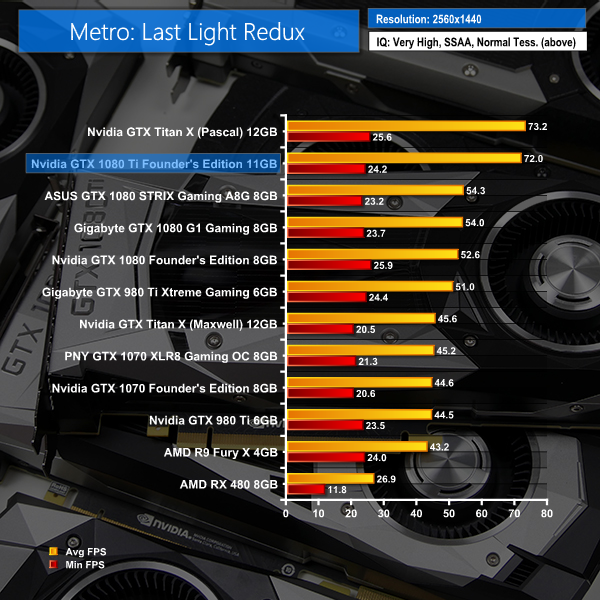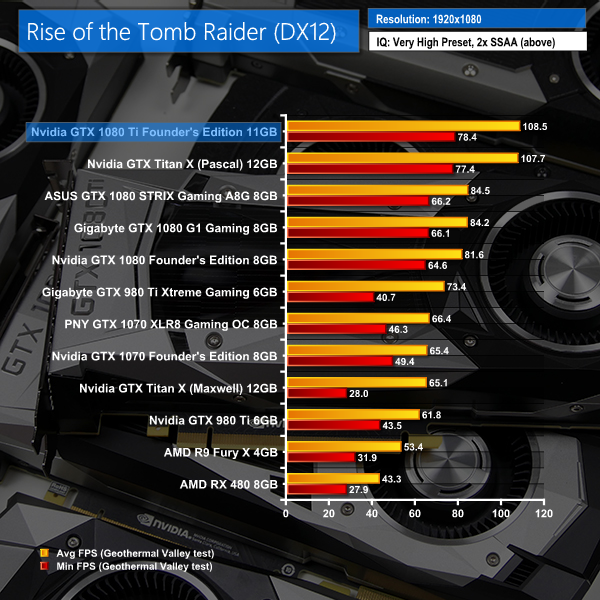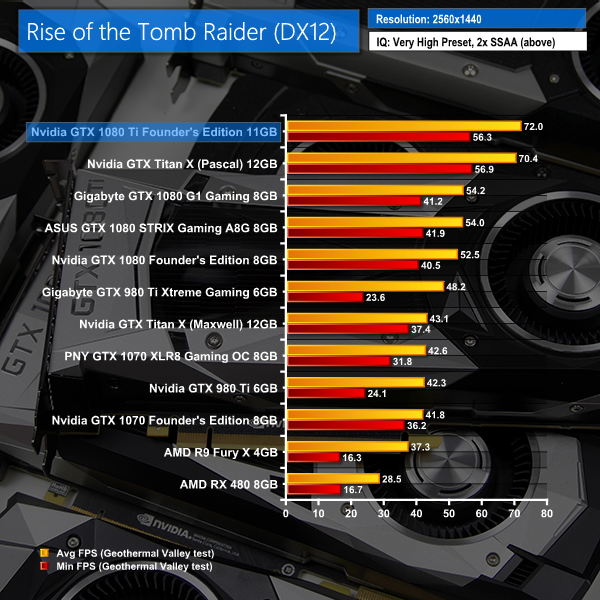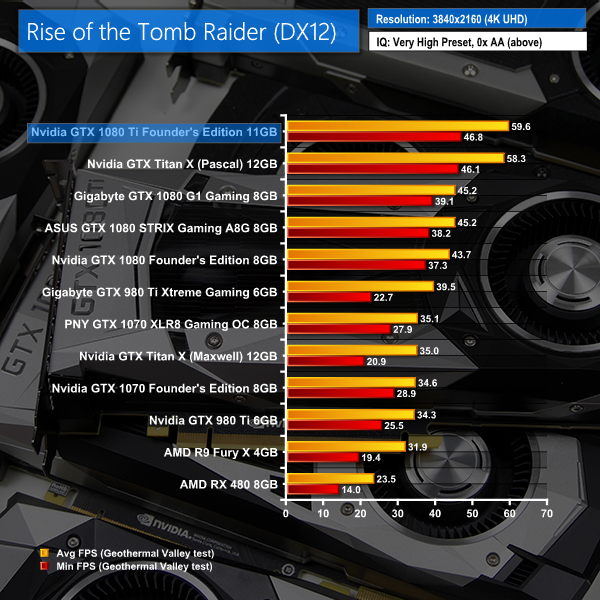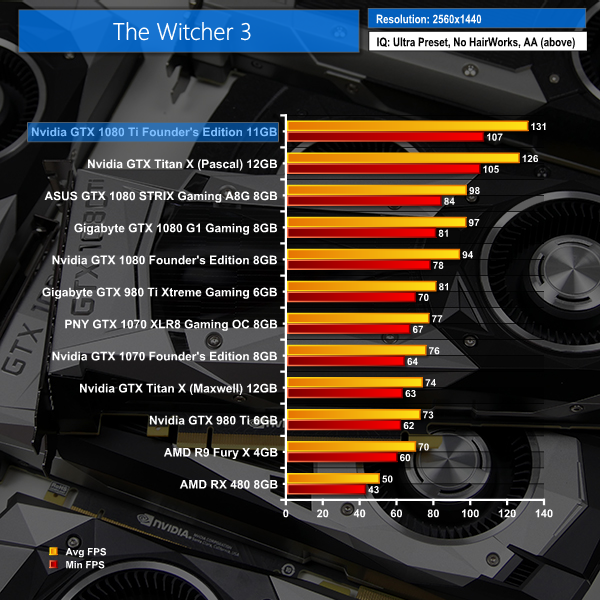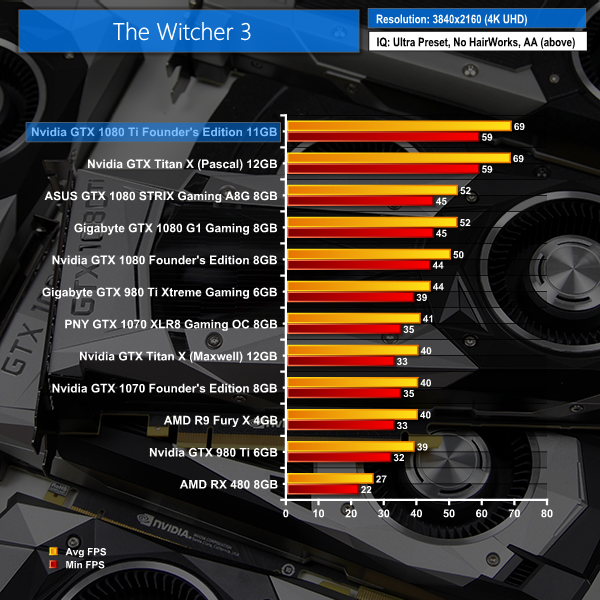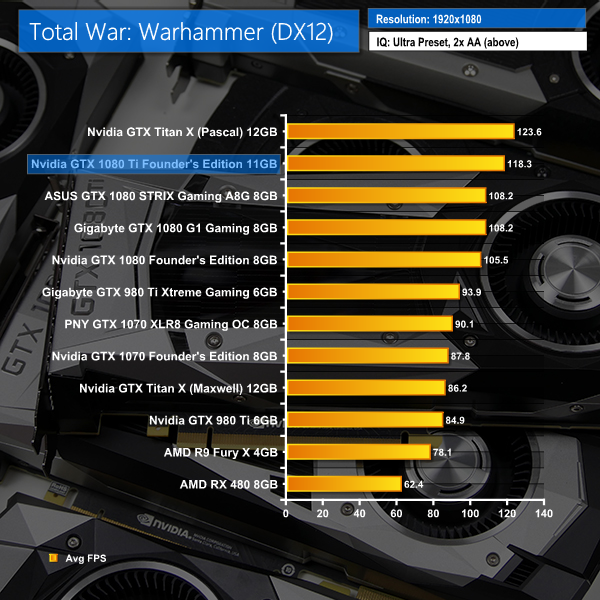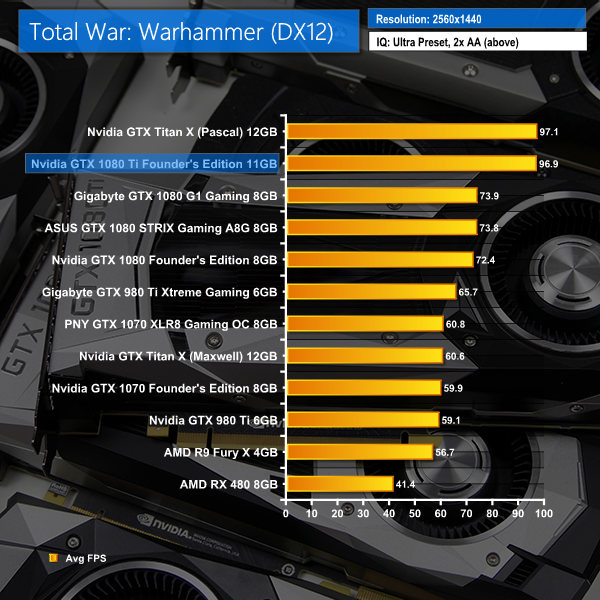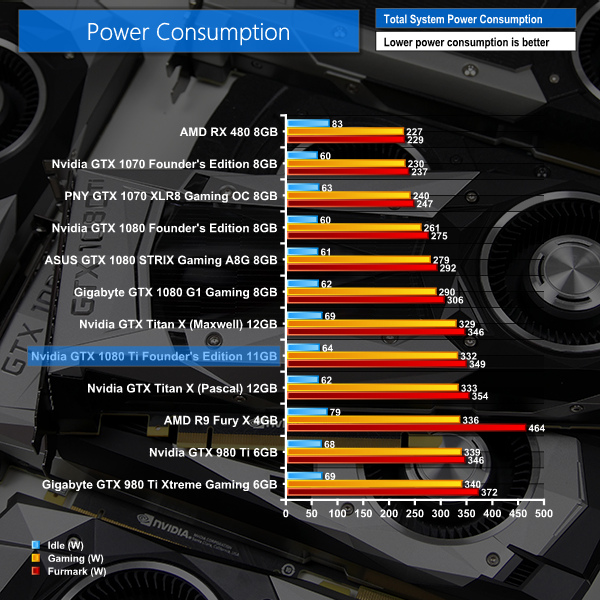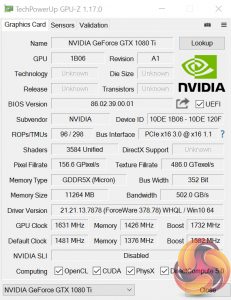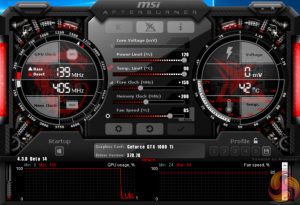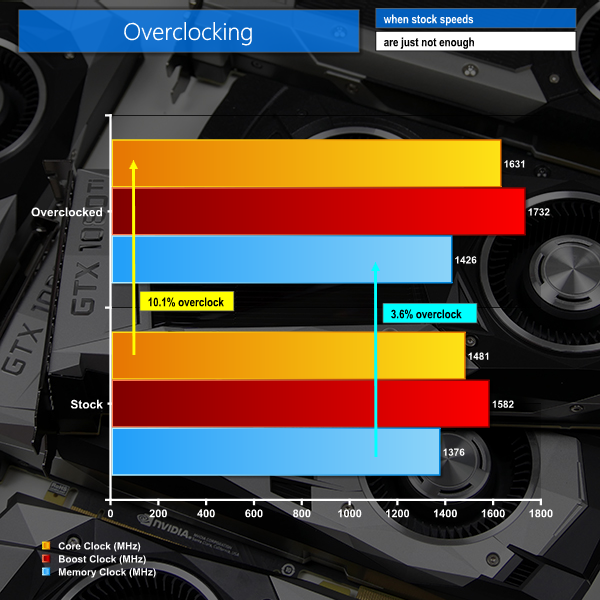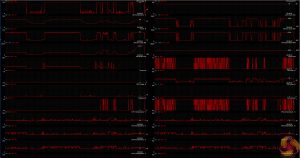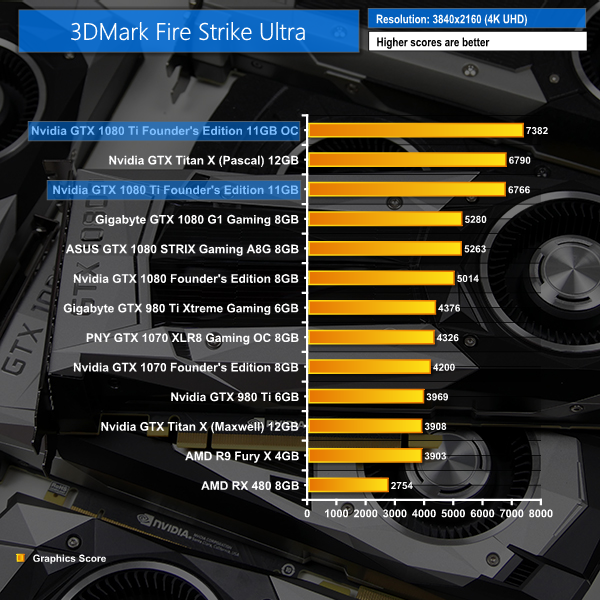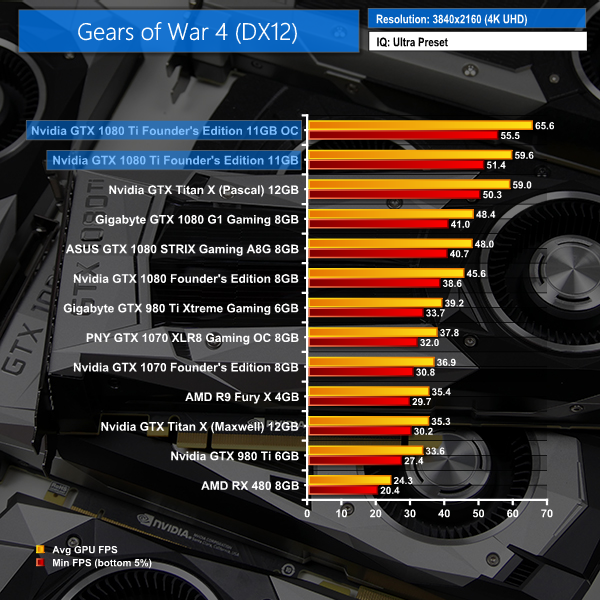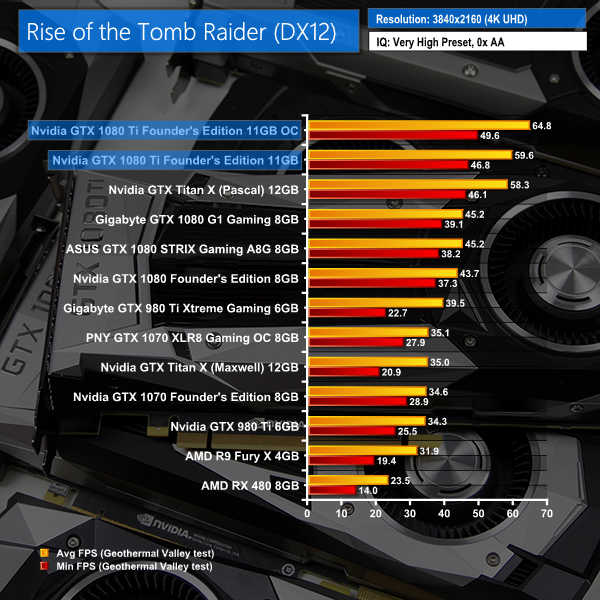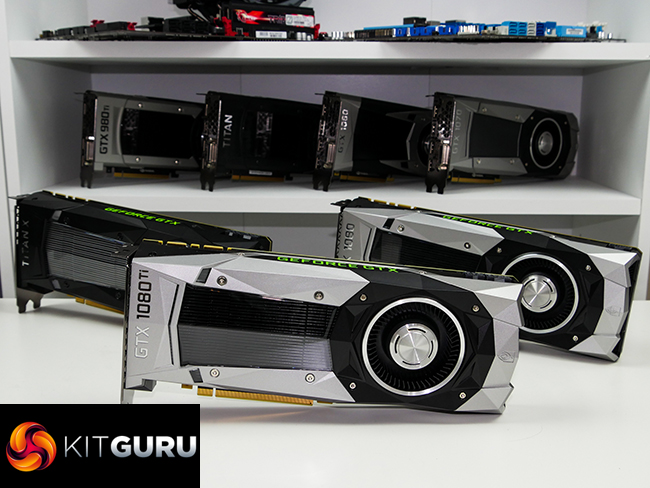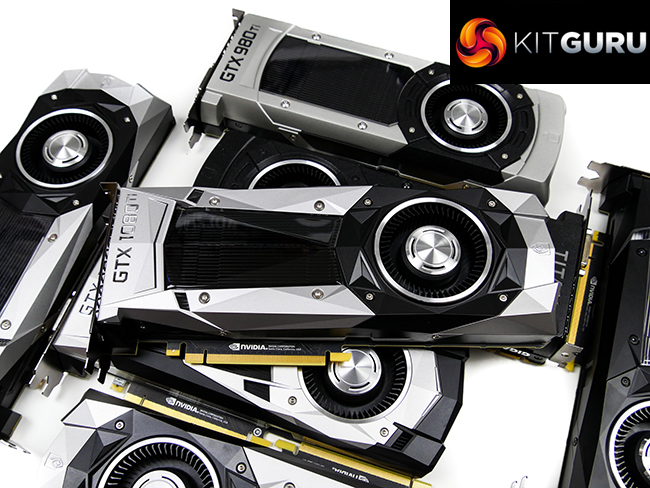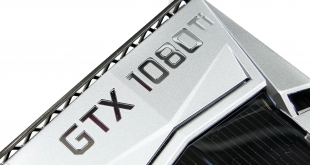
Nvidia's Titan X Pascal has been dominating at the top of GPU performance charts for a little over seven months, with the gap to the Santa Clara-based GPU maker's second-in-line GTX 1080 being a sizeable one. With AMD's high-end competitors still not available for public adoption, the enthusiast market is ready for a GTX 1080 Ti GPU to offer Titan X-like performance at a price point closer to that of a high-end offering, rather than an ultra-high-end (borderline silly-money) one.
Along comes the GTX 1080 Ti. Take the GP102 GPU used in a Titan X Pascal – chop off one twelfth of certain areas, bump up the core clock speed by 63MHz and you get the GTX 1080 Ti. Oh, and let's not forget a £480 price reduction thrown in for good measure. Of course, there's more to it than that basic overview. The cooler has been tweaked, power delivery components are changed, and you now get 11 Gigabytes of faster 11Gbps GDDR5X VRAM versus the Titan X Pascal's 12 Gigs of 10Gbps GDDR5X. Reading between the lines, the expectation of slightly higher performance than a Titan X Pascal, driven by a higher core clock and faster memory, for a £699 asking fee looks like a good proposition.
With Nvidia's announcement for the GTX 1080 Ti last week came a whole round of product stack shake-ups. Titan X Pascal said so-long, GTX 1080 got a $100 price shave which also pushed down GTX 1070 fees, and new GTX 1080 and GTX 1060 models with faster VRAM were shown to be inbound. ‘What was the driving force behind this series of changes?' I hear you asking. No, AMD hasn't released a new high-end – Vega – GPU (yet). Instead, it the was the promise of Titan X-level performance from the $699 GTX 1080 Ti.
If you have been craving a true 4K60 single-GPU solution and simply could not justify spending more than £1k on a Titan X Pascal, you may want to pay attention to the £699 GTX 1080 Ti (yes, UK punters will pay a straight dollar to pound amount). Nvidia is claiming that the new 11GB card delivers 35% higher performance than a GTX 1080, making it the GPU vendor's biggest leap for a Ti-branded card. Single-card high-resolution and high-refresh rate gaming looks to have been made more affordable. That's even before AMD has entered the market with Vega competition. Who'd have thought?
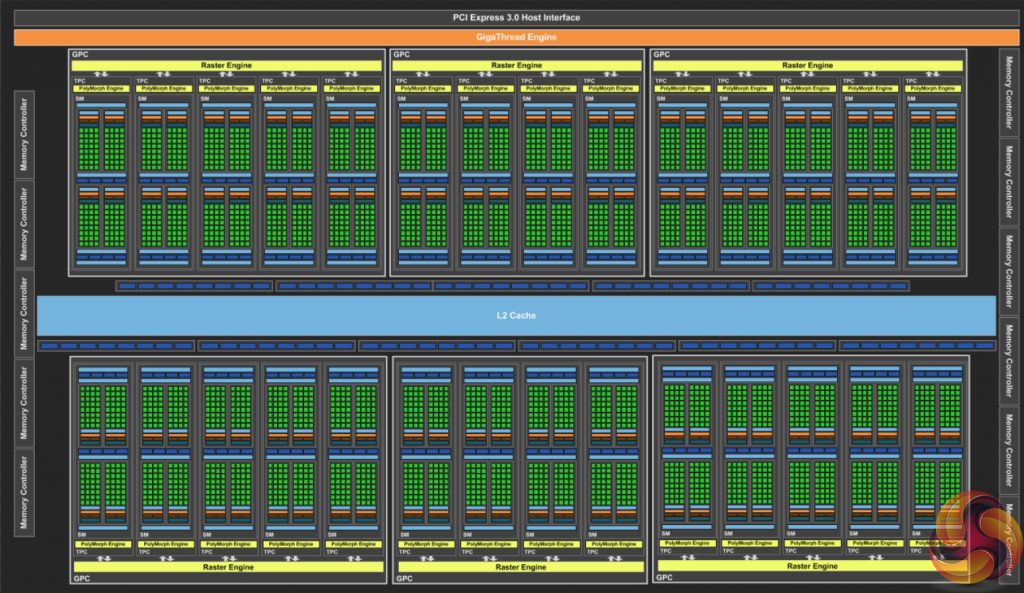
Nvidia is calling GTX 1080 Ti ‘the ultimate gamer GPU‘. Substantiating those claims is the application of the same 471mm2 GP102 GPU core found on the company's Titan X Pascal flagship consumer graphics card which is fabbed using a 16nm process. Nvidia adjusts the chip by disabling certain components which results in a one twelfth reduction to the number of ROPs, the amount of L2 cache, the associated memory bus width, and the quantity of VRAM. Those figures sit at 88 ROPs (vs Titan XP's 96), 2816 KB of L2 cache (vs Titan XP's 3072 KB), a 352-bit memory bus (vs Titan XP's 384-bit), and 11GB of GDDR5X VRAM (vs Titan XP's 12GB).
With a reduction in the number of on-chip components fighting for power and cooling comes headroom in the 250W TDP budget. Nvidia re-invests that TDP headroom by bumping the core clock up by 63MHz to 1480MHz which results in rated GPU Boost 3.0 frequency being improved by 61MHz to 1582MHz. This takes the GTX 1080 Ti's compute power to more than 11 TFLOPS.
Faster GDDR5X memory is also used. Compared to the Titan XP and its 10Gbps VRAM, the GTX 1080 Ti uses 11Gbps GDDR5X that Nvidia says it was able to achieve by working with DRAM partners to use advanced equalisation techniques, enhance signalling quality, and refine the data channel to the DRAM. The 10% increase in memory frequency versus Titan XP offsets GTX 1080 Ti's 8.3% reduction in bus width to give it greater memory bandwidth at 484GBps against Titan XP's 480GBps.
| GPU | Nvidia GTX 1060 6GB | Nvidia GTX 1070 | Nvidia GTX 1080 | Nvidia GTX Titan X (Pascal) | Nvidia GTX 1080 Ti |
| GPU Name | GP106 | GP104 | GP104 | GP102 | GP102 |
| Streaming Multiprocessors | 10 | 15 | 20 | 28 | 28 |
| GPU Cores | 1280 | 1920 | 2560 | 3584 | 3584 |
| Base Clock | 1506 MHz | 1506 MHz | 1607 MHz | 1417 MHz | 1480 MHz |
| GPU Boost Clock | 1709 MHz | 1683 MHz | 1733 MHz | 1531 MHz | 1582 MHz |
| Total Video Memory | 6GB GDDR5 | 8GB GDDR5 | 8GB GDDR5X | 12GB GDDR5X | 11GB GDDR5X |
| Texture Units | 80 | 120 | 160 | 224 | 224 |
| Texture fill rate | 120.5 GT/s | 180.7 GT/s | 257.1 GT/s | 317 GT/s | 331.5 GT/s |
| Memory Clock | 8Gbps effective | 8 Gbps effective | 10 Gbps effective | 10 Gbps effective | 11 Gbps effective |
| Memory Bandwidth | 192.2 GB/s | 256.3 GB/s | 320 GB/s | 480 GB/s | 484 GB/s |
| Bus Width | 192-bit | 256-bit | 256-bit | 384-bit | 352-bit |
| ROPs | 48 | 64 | 64 | 96 | 88 |
| Manufacturing Process | 16nm | 16nm | 16nm | 16nm | 16nm |
| TDP | 120 W | 150 W | 180 W | 250 W | 250 W |
| Power Connector(s) | 1x 6-pin | 1x 8-pin | 1x 8-pin | 1x 6-pin + 1×8-pin | 1x 6-pin + 1×8-pin |
| Current UK Starting Price | Approx. £230 | Approx. £360 | Approx. £470 | £1,179 (End of Line) | £699 |
Compared to Titan XP, the GP102 implementation for GTX 1080 Ti retains the 28 Streaming Multiprocessor Units (SMUs), 3584 CUDA cores, and 224 Texture Units. It is a 12 Billion transistor, 471mm2 GPU fabbed on TSMC's 16nm process technology. The 250 W TDP commands 6-pin plus 8-pin PCIe power connectors and a cooling solution that can keep pace up to the 83°C default (user-adjustable) thermal throttling point of GPU Boost 3.0 (the GPU's thermal threshold is 91°C).
GTX 1080 Ti isn't quite GTX 1080-and-a-half, as Titan X Pascal could crudely be described. But it isn't far off that level of raw numerical data on the specification sheet, either. In return for a 70W (39%) increase in TDP versus GTX 1080 and a ~£200 higher price tag, adopters are returned with the promise of 35% higher performance at the GTX 1080 Ti Founder's Edition's operating specifications.
For more details on the technologies found in Nvidia's Pascal-based graphics cards, please read our launch review of the GTX 1080 HERE.
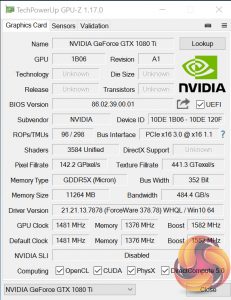
Nvidia rates the GTX 1080 Ti Founder's Edition Boost frequency at 1582MHz. During our testing, we observed GPU Boost 3.0 taking the core speed as high as around 1860MHz before either power- or thermal-induced throttling kicked in. We will not be surprised to see after-market, custom-cooled, factory-overclocked cards from board partners hitting more than 1900MHz in gaming usage out-of-the-box.
Our GTX 1080 Ti Founder's Edition sample shipped directly from Nvidia in a box that has become synonymous with the Pascal FE cards.
Nvidia supplies a DisplayPort-to-DVI (dual-link DVI-D) adapter due to the GTX 1080 Ti's slight redesign on the rear IO. DVI has been dropped and is now supported via the supplied DP-to-DVI adapter or by converting the onboard HDMI 2.0 connection.
The Founder's Edition cooler used on the GTX 1080 Ti features similarities to that found on the GTX 1080. A die-cast aluminium body houses the cooling system that comprises a copper vapour chamber in contact with the GPU, an aluminium fin array, and a radial fan that forces air towards the rear vent.
Measuring 10.5″ in length, standard width for a PCIe expansion card, and conforming to a dual-slot form factor, compatibility is key to the Founder's Edition design logic. Nvidia has created a card that can be installed inside a variety of systems, from a standard ATX-sized chassis to a mini-ITX build with limited cooling space and case airflow.
The rear-exhaust cooling method, as opposed to internally-venting coolers found on many after-market cards, is designed to dump a significant proportion of the heat outside of the chassis thus reducing the requirement for strong case airflow to maintain suitable operation.
Backplate design follows the same two-plate split methodology applied for the GTX 1080 Founder's Edition and Titan X Pascal cards. Two thin metal backplates connect separately to the rear PCB allowing them to be removed individually. This has the benefit of allowing the single backplate piece residing behind the radial fan to be removed to create a small cooling gap if a pair of GTX 1080 Ti cards is installed back-to-back in SLI.
Other than a more aesthetically-pleasing appearance than a bare PCB, backplates on GPUs are able to aid structural rigidity of the card. They can also passively transfer heat away from the PCB, if designed correctly.
Silver, black, and a hint of green is the go-to style for Nvidia's Founder's Edition cards and the GTX 1080 Ti continues that trend. The side-mounted ‘GEFORCE GTX‘ logo is coloured green and features an LED that can be controlled via software, though not with particularly advanced functionality or RGB options.
The angled design of Nvidia's new cooler it introduced with Pascal cards seems to have been well received by enthusiasts who like the styling and largely two-tone appearance.
Tipping the scales at just over 1kg, much of which can be attributed to the cooler, it is easy to understand the challenge of designing a 250W-capable cooling system with such limited volumetric (not to mention cost) constraints. The GTX 1080 Ti FE weighs the same as both the Titan XP and the GTX 1080 FE, despite the latter using a lower speed fan (which could be software limited).
Nvidia's marketing material is claiming 2x the airflow area over the GTX 1080 for the GTX 1080 Ti Founder's Edition cooler. However, this basically seems to be an interpretation of the rear IO venting space gained by removing the DVI port. So don't be misled by claims of 2x the airflow area as it doesn't directly translate into real world performance. That's especially true for fluids such as air that can simply undergo a change in flow velocity to be forced through smaller cooling gaps meaning that area isn't the only metric of importance.
Power is delivered to the GTX 1080 Ti through a combination of side-mounted 8-pin and a 6-pin PCIe power connectors. We expect to see board partners shipping factory-overclocked cards that leverage dual 8-pin PCIe power connectors, or perhaps even a trio for overclocking-geared SKUs.
TDP, which isn't technically power draw but serves as a rough estimation, sits at 250W and Nvidia recommends pairing GTX 1080 Ti with a 600W PSU.
A pair of gold fingers provide SLI support for the GTX 1080 Ti. If you have deep pockets and high graphical demands in your games, coupling together a pair of GTX 1080 Ti graphics card will require the use of a high-bandwidth SLI bridge for the highest level of performance.
More information relating to Nvidia's approach to SLI with Pascal can be found HERE.
Here comes one of the biggest changes for Nvidia's GTX 1080 Ti graphics card – the rear IO. Nvidia opts for a combination of triple DisplayPort 1.4-ready connections and an HDMI 2.0b output. The DVI port has been dropped, meaning that you'll have to rely upon an HDMI to DVI or DisplayPort to DVI (included) adapter. The decision to drop DVI is driven by the real estate it commands on the rear IO backplate and Nvidia's thoughts that the space is better allocated to additional cooling ventilation.
As a triple-monitor user for my workstation PC, I am sad to see DVI being dropped. However, I completely understand the decision and like that Nvidia includes an adapter for users with older monitors that don't support HDMI 2.0 and who don't want the Windows headaches introduced by DisplayPort. Expect board partner cards to restore the DVI output. It's also likely that some vendors will switch out one of those DisplayPort connectors in favour of an additional HDMI port that's more convenient for VR users.
One of the main positives I see from switching to a single row of display outputs is liquid cooling support. The possibility for single-slot liquid-cooled cards has returned and it doesn't involve chopping off one's DVI port on a £699 graphic card!
Eleven GDDR5X memory chips comprise the 11GB of VRAM. Nvidia has enhanced the power delivery system compared to the GTX 1080 Founder's Edition. A 7-phase control system drives a total of 14 dual-FETs with a rated power capacity of 250 Amps for the GPU.
This is an upgrade from the GTX 1080 both in terms of control channels and FET count, as the GTX 1080 Ti now uses two dual FETs per control channel, as opposed to one. It is also an upgrade from the Titan X Pascal's power delivery solution which is likely to translate into slightly higher electrical efficiency or better overclocking.
Our newest GPU test procedure has been built with the intention of benchmarking high-end graphics cards. We test at 1920×1080 (1080p), 2560×1440 (1440p), and 3840×2160 (4K UHD) resolutions.
We try to test using the DX12 API if titles offer support. This gives us an interpretation into the graphics card performance hierarchy in the present time and the near future, when DX12 becomes more prevalent. After all, graphics cards of this expense may stay in a gamer's system for a number of product generations/years before being upgraded.
General Test System Notes
- AMD Graphics cards were benchmarked with the AMD Crimson Display Driver 16.11.4.
- Nvidia Graphics cards were benchmarked with the Nvidia Forceware 375.70 driver.
- The Nvidia GTX 1080 Ti was benchmarked with a new Nvidia Forceware 378.78 driver to support the new card.
Test System
| CPU |
Intel Core i7 6700K ‘Skylake' (Retail)
Overclocked to 4.4GHz Core, 4.4GHz Cache |
| Motherboard |
ASUS Maximus VIII Hero
|
| Memory |
G.Skill Trident Z
16GB (2x8GB) @ 3000MHz 16-18-18-38-2T |
| Graphics Card |
Varies
|
| System Drive |
Micron M600 256GB SATA 6Gbps SSD
|
| Games Drive | SK hynix SE3010 960GB SATA 6Gbps SSD |
| Chassis | NZXT Phantom 630 (medium fan speed) |
| CPU Cooler |
Corsair H110i GT
|
| Power Supply |
Seasonic SS-760XP 760W Platinum
|
| Operating System |
Windows 10 Professional with Anniversary Update (64-bit)
|
Our test system consists of an overclocked Core i7-6700K processor and 16GB of 3000MHz G.Skill DDR4. High-end hardware is used to eliminate CPU and memory from the bottleneck equation and put the performance onus solely on the GPU being tested.
Comparison Graphics Cards List
AMD RX 480 8GB Reference (1266MHz core / 2000MHz memory)
AMD R9 Fury X (1,050MHz core / 500MHz memory)
Nvidia GTX Titan X (Pascal) (1418MHz core / 1531MHz Boost / 1251MHz memory)
Gigabyte GTX 1080 G1 Gaming (1696MHz core/ 1835MHz Boost / 1251MHz memory)
ASUS ROG STRIX GTX 1080 Gaming A8G (1671MHz core/ 1810MHz Boost / 1251MHz memory)
Nvidia GTX 1080 Founders Edition (1607MHz core/ 1734MHz boost / 1251MHz memory)
PNY GTX 1070 XLR8 OC (1607MHz core/ 1797MHz boost / 2002MHz memory)
Nvidia GTX 1070 Founders Edition (1506MHz core/ 1683MHz boost / 2002MHz memory)
Nvidia GTX Titan X (Maxwell) (1,000MHz core / 1,753MHz memory)
Gigabyte GTX980 Ti XTREME Gaming (1216MHz core / 1800MHz memory)
Nvidia GTX980 Ti Reference (1000MHz core / 1,753MHz memory)
Software and Games List
- 3DMark Fire Strike & Fire Strike Ultra (DX11 Synthetic)
- 3DMark Time Spy (DX12 Synthetic)
- VRMark Blue Room (Synthetic)
- Unigine Heaven (DX11 Synthetic)
- Ashes of the Singularity (DX12)
- Deus Ex: Mankind Divided (DX12)
- Gears of War 4 (DX12)
- Grand Theft Auto V (DX11)
- Metro Last Light Redux (DX11)
- Rise of the Tomb Raider (DX12)
- The Witcher 3: Wild Hunt (DX11)
- Total War: Warhammer (DX12)
3DMark Fire Strike is a showcase DirectX 11 benchmark designed for today's high-performance gaming PCs. It is our [FutureMark's] most ambitious and technical benchmark ever, featuring real-time graphics rendered with detail and complexity far beyond what is found in other benchmarks and games today.
The GTX 1080 Ti Founder's Edition makes a solid start in the FutureMark benchmarks. 3DMark's Fire Strike tests place the new GP102-powered card slightly behind the Titan X Pascal due to the reduction in GPU on-chip components. Time Spy, however, shows preference for the higher clock speed of the GTX 1080 Ti and sees it sat at the top of the chart.
A performance increase of 32% in Fire Strike is obtained by going from GTX 1080 FE to GTX 1080 Ti FE. That margin increases to 35% using the 4K Fire Strike Ultra test. The difference is 33% in favour of GTX 1080 Ti FE for Time Spy.
Whichever way you break it down, the performance differences between the GTX 1080 Ti FE and Titan XP are minor. In GTX 1080 Ti, you are basically getting Titan XP performance for £480 less, according to 3DMark.
Futuremark's new VRMark benchmark is the latest addition to our test suite. The recently-released benchmark aims to score GPUs based on their VR performance potential by using rendering resolutions associated with VR devices of today and the future.
The Blue Room test and its 5120×2880 rendering resolution, on the other hand, is an absolute killer for graphics cards but it does show tangible gains when stepping up through the performance hierarchies.
Note: We have removed the Orange Room test as its performance with newer drivers and a software update make previously gathered data incomparable.
You are going to need a pair of these cards if you want to power the ultra-high resolution VR devices of tomorrow, according to VRMark's Blue Room test. GTX 1080 Ti is a hair faster than Titan XP in this one and its performance increase over the GTX 1080 Ti FE is 37%.
You'd need a pair of AMD's highest-performance single-GPU cards to get to a GTX 1080 Ti level of of performance. Vega is overdue for Team Red.
Unigine provides an interesting way to test hardware. It can be easily adapted to various projects due to its elaborated software design and flexible toolset. A lot of their customers claim that they have never seen such extremely-effective code, which is so easy to understand.
Heaven Benchmark is a DirectX 11 GPU benchmark based on advanced Unigine engine from Unigine Corp. It reveals the enchanting magic of floating islands with a tiny village hidden in the cloudy skies. Interactive mode provides emerging experience of exploring the intricate world of steampunk. Efficient and well-architected framework makes Unigine highly scalable:
- Multiple API (DirectX 9 / DirectX 10 / DirectX 11 / OpenGL) render
- Cross-platform: MS Windows (XP, Vista, Windows 7) / Linux
- Full support of 32bit and 64bit systems
- Multicore CPU support
- Little / big endian support (ready for game consoles)
- Powerful C++ API
- Comprehensive performance profiling system
- Flexible XML-based data structures
We set Quality to ‘Ultra’, Tessellation to ‘disabled’, Anti-Aliasing to 2x and the resolution to 2560×1440 (1440p).
GTX 1080 Ti takes second place to the Titan XP in Unigine's Heaven benchmark, largely due to thermal throttling induced by the Founder's Edition cooler. We ran this test at a higher fan speed to eliminate thermal throttling and registered a score of 142.8 FPS for the GTX 1080 Ti.
However, that's not how the card performs out of the box so it's not the performance displayed on the chart. Compared to the GTX 1080 at reference frequencies, GTX 1080 Ti is 41% faster in this test.
Ashes of the Singularity is a real-time strategy game set in the future where descendants of humans (called Post- Humans) and a powerful artificial intelligence (called the Substrate) fight a war for control of a resource known as Turinium.
Players will engage in massive-scale land/air battles by commanding entire armies of their own design. Each game takes place on one area of a planet, with each player starting with a home base (known as a Nexus) and a single construction unit.
We opt for the Extreme quality profile and run the GPU-Focused test using the DX12 game mode.
Note: 4K data showed a performance change likely due to a game update. As such, we removed invalid data and re-tested the Titan X (Pascal) to compare against the GTX 1080 Ti FE. The differences at 1440P and 1080P were within margin of error of the test procedure and therefore the previously gathered data remains.
A clean-sweep of chart-topping results is displayed by the GTX 1080 Ti FE. Thermal throttling didn't have a huge influence on performance at 4K in Ashes of the Singularity. If you want to drive this game with Extreme image quality and at more than 4K60, the GTX 1080 Ti fits the bill.
The increase in performance over GTX 1080 FE is 22% at 1080P (which is hamstrung by CPU bottlenecking) and 30% at 1440P. Though we don't have GTX 1080 FE data at 4K due to a driver change, its performance level is around 15-20 FPS lower than the GTX 1080 Ti FE.
1440P users wanting to upgrade from their ageing AMD R9 Fury X or overclocked GTX 980 Ti can expect a performance increase in the order of 50%.
Deus Ex: Mankind Divided is set in the year 2029, two years after the events of Human Revolution and the “Aug Incident”—an event in which mechanically augmented humans became uncontrollable and lethally violent.
Unbeknownst to the public, the affected augmented received implanted technology designed to control them by the shadowy Illuminati, which is abused by a rogue member of the group to discredit augmentations completely. (Wikipedia).
We test using the Ultra quality preset at 1080p and 1440p. The Very High preset was used for 4K. We used the DirectX 12 API.
GTX 1080 Ti delivers an average frame rate of more than 100 FPS in Deus Ex's challenging Ultra setting at 1080P. The card also makes the game playable at 1440P with Ultra quality. All three resolutions favour the GTX 1080 Ti FE and its higher clock speeds over the vastly more expensive Titan X Pascal.
GTX 1080 FE performance is bettered by the GTX 1080 Ti by 33% at 1080P, 34% at 1440P, and 37% at 4K (despite no setup playing particularly smoothly with the 8MP resolution). If you are a 1440P gamer looking to upgrade your R9 Fury X or GTX 980 Ti, expect a performance increase to the tune of two thirds in Deus Ex.
The Gears Of War 4 game’s plot is set 25 years after Gears of War 3 and focuses on JD Fenix, the son of Marcus Fenix. Gears of War is a third-person shooter game, with its core concepts being derived from Resident Evil 4‘s “over the shoulder” perspective, Kill Switch‘s cover system, and Bionic Commando‘s swinging action akin to moving between points of cover. (Wikipedia).
Gears of War 4 is launched via the Windows 10 Store, requires the Windows 10 Anniversary Update to run, and only supports the DirectX 12 API.
We test using the Ultra quality preset. Dynamic Resolution scaling was turned off and Async Compute was enabled where the GPU supported it.
Another clean-sweep at the top of the charts for GTX 1080 Ti in Gears of War 4. With GTX 1080 Ti, Titan XP performance is bettered, you can push past 100 FPS at 1440P, and 4K60 is perfectly playable. A solid offering from the GTX 1080 Ti FE card to gamers who like Gears of War 4.
GTX 1080 FE performance is beaten by 22% at 1080P (held back by CPU bottlenecking), 26% at 1440P, and 31% at 4K. If you are a 1440P gamer, the GTX 1080 Ti FE doesn't look like such good value compared to GTX 1080 FE when the price and performance are categorised. However, if you want a single-card solution to your 4K gaming needs, the GTX 1080 Ti FE gives you that and it's performance gap over alternative options (ignoring Titan XP) is significant.
Grand Theft Auto V is an action-adventure game played from either a first-person or third-person view. Players complete missions—linear scenarios with set objectives—to progress through the story. Outside of missions, players may freely roam the open world.
Composed of the San Andreas open countryside area and the fictional city of Los Santos, the world is much larger in area than earlier entries in the series. It may be fully explored after the game’s beginning without restriction, although story progress unlocks more gameplay content.
We use the Ultra quality settings (or the highest alternative – generally Very High or High – when Ultra is unavailable). MSAA is set to 2x for 1080p and 1440p and is disabled for 4K. The Advanced Graphics options are all set to their maximum levels.
At 1080p the game suggests 3469MB of VRAM usage. At 1440p that number increases to 3764MB. At 4K the video memory usage is quoted as 4171MB.
GTX 1080 Ti FE can push an average frame rate of more than 100 FPS at 1080P in GTA V. That number stays close to 100 FPS when the resolution is cranked to 1440P and image quality settings remain at their maximum levels with 2x MSAA. GTX 1080 Ti FE delivers a solid 4K60 experience with settings set to the highest levels (no AA) in GTA V.
With settings- and CPU-induced bottlenecks less visible at 4K, GTX 1080 Ti delivers a 32.5% improvement over the GTX 1080 FE's performance level. It's the difference between a close-to-60FPS gameplay experience and one that sits above 60FPS for much of the time. GTX 980 Ti users from yesteryear can expect to see a performance improvement of 75% (!) at 4K by upgrading to the GTX 1080 Ti. That performance increase is closer to 90% for R9 Fury X users, thanks to the game's slight preference for Nvidia hardware an affinity for VRAM.
Just like the original game Metro 2033, Metro: Last Light is played from the perspective of Artyom, the player-character. The story takes place in post-apocalyptic Moscow, mostly inside the metro system, but occasionally missions bring the player above ground. Metro: Last Light takes place one year after the events of Metro 2033, following the canonical ending in which Artyom chose to proceed with the missile strike against the Dark Ones (this happens regardless of your actions in the first game). Redux adds all the DLC and graphical improvements.
At 1080p and 1440p, we test using a Very High quality profile with SSAA enabled and Tessellation set to Normal. At 4K we drop the quality profile down to High and disable SSAA.
Worth noting is that minimum FPS numbers for this game should be interpreted with caution as they tend to show high levels of variance between benchmark runs.
Nvidia's GTX 1080 Ti FE continues to show excellent performance in games. This time, however, it trails the Titan XP by a very minor amount at 1080P and 1440P. Thermal throttling doesn't have a huge influence on results here as the 1080 Ti's average 4K frame rate only improved to 90.7 FPS in our testing with a higher fan speed.
If you game at 1080P on a high-refresh rate monitor, GTX 1080 Ti can keep you above 120 FPS average using the same settings as we did. The magic 60FPS mark is also surpassed at both 1440P and 4K (with less demanding IQ settings). The performance increase for GTX 1080 Ti over GTX 1080 is 37% at all three resolutions. How about that for consistency?
Rise of the Tomb Raider is a third-person action-adventure game that features similar gameplay found in 2013’s Tomb Raider. Players control Lara Croft through various environments, battling enemies, and completing puzzle platforming sections, while using improvised weapons and gadgets in order to progress through the story.
It uses a Direct X 12 capable engine.
At 1080p and 1440p, we use the Very High quality preset and 2x SSAA. At 4K we disable AA completely. The DirectX 12 API is used. Numbers are taken from the benchmark's Geothermal Valley test.
Another chart-topping display from the GTX 1080 Ti FE when it comes to Rise of The Tomb Raider in its DX12 mode. The game is playable at its highest – Very High – image quality settings at all three resolutions. You can even throw some SSAA into the mix at 1440P while maintaining an average above 60FPS on the GTX 1080 Ti.
The GTX 1080 Ti's 11GB of VRAM proved useful (to an extent) in ROTTR as we saw usage peaking just above 8GB at 4K.
The performance improvement from GTX 1080 FE to GTX 1080 Ti FE is 33% at 1080P, 37% at 1440P, and 36% at 4K. R9 Fury X users can expect a performance improvement close to 90% at 4K by switching to the GTX 1080 Ti FE. That number sits at 74% for 4K gamers with a reference-clocked GTX 980 Ti. Not a bad improvement in the space of one generation, to say the least.
The Witcher 3: Wild Hunt concludes the story of the witcher Geralt of Rivia, whose story to date has been covered in the previous titles.[3] Continuing from The Witcher 2, Geralt seeks to move on with his own life, embarking on a new and personal mission while the world order itself is coming to a change. (Wikipedia).
We use the Ultra preset for general image quality, but disable the Nvidia HairWorks settings where possible. The post-processing preset is set to High. We benchmark a 107-second run through a densely-populated area of the game.
Another trio of chart-topping results displayed by the GTX 1080 Ti FE in The Witcher 3. This game average more than 60FPS at all resolutions with the GTX 1080 Ti, maximum image quality settings, and the Nvidia Hairworks graphics features disabled. In fact, high-refresh rate gamers are superbly catered for at 1440P and 1080P with average GTX 1080 Ti FE frame rates hitting 131FPS and 179FPS, respectively.
The performance increase for GTX 1080 Ti over the GTX 1080 FE is 30% at 1080P, 39% at 1440P, and 38% at 4K. Gamers with a GTX 980 Ti or R9 Fury X can expect an average performance improvement of 77% and 73%, respectively, at 4K. That's the difference between a borderline unplayable gaming experience and one that is buttery-smooth at 4K.
If you want a single card to play this game at 4K60 or 1440P 100FPS+, the GTX 1080 Ti FE offers you just that. Better yet, you don't have to cough up more than £1k for it, like you did with the Titan XP.
Total War: Warhammer is a turn-based strategy game with real-time tactical battles between armies. While previous Total War games feature historical settings, Warhammer introduces a fantasy setting as well as characters from the Warhammer universe. These characters, which include monsters, warriors, and heroes, can be controlled by the player. (Wikipedia)
We set the image quality options all to Ultra. At 1080p and 1440p, AA is set to 2x but it is disabled for 4K testing. The DirectX 12 API is used.
Nvidia's GTX 1080 Ti sits close to the first place levels in Total War: Warhammer, though it does trade positions with the Titan XP at lower resolutions (which is also influenced by CPU bottlenecking). If you are a 4K60 gamer, the GTX 1080 Ti FE gives you a single card solution for pushing past a 60FPS average in this title.
Compared to the GTX 1080 FE, GTX 1080 Ti offers performance increases of 12% at 1080P (due to CPU bottlenecking), 34% at 1440P, and 38% at 4K. Gamers with a 4K monitor and GTX 980 Ti or R9 Fury X will see an average frame rate increase of 71% and 61%, respectively.
We first measure power while the card is sat idling at the Windows 10 desktop for 5 minutes. Gaming power draw is recorded by running Unigine Heaven DX11 benchmark for 5 minutes. As a maximum stress test, Furmark is run for 5 minutes and the cards' power draw levels are recorded.
Unsurprisingly, given the similarities in the GPU used and board TDP, power draw for the GTX 1080 Ti FE is almost identical to that of the Titan X Pascal. The card sips power when idling at the Windows desktop but quickly ramps up to command far more than 200W under load.
Total system power draw from the wall was measured as 332W when running Unigine Heaven benchmark at 1440P. Nvidia recommends a 600W PSU for the GTX 1080 Ti FE and we wouldn't disagree with them when accounting for a CPU load and some headroom.
Compared to the GTX 1080 FE, the GTX 1080 Ti FE commands 27% more power under gaming load. That's a very fair return for a performance improvement that generally sits in the mid-30s percentage range. GTX 1080 Ti FE regularly offers performance increases in the region of 70%+ to GTX 980 Ti and AMD R9 Fury X users. Equally impressive is that it does so while consuming marginally less power (though you'll be unlikely to notice the difference outside of Furmark).
We first measure GPU temperature while the card is sat idling at the Windows 10 desktop for 5 minutes. Gaming GPU temperature is recorded by running Unigine Heaven DX11 benchmark for 5 minutes. As a maximum stress test, Furmark is run for 5 minutes and the cards' GPU temperature levels are recorded.
Ambient room temperature was held at around 19-20°C.
Thermal performance from the GTX 1080 Ti's Founder's Edition cooler is somewhat of a known entity thanks to its application on the Titan XP. The unit does its job at dissipating 250W of thermal energy but it does so while allowing the GPU to hit its 83°C thermal throttling point that causes a reduction in the core frequency.
With the fan speed sitting around the 50% level under heavy load and the clock dropping by around 50-100MHz due to temperatures, we struggle to understand why Nvidia opts for such a conservative fan speed curve on a high-performance, enthusiast graphics card. We applied our own, more aggressive, fan curve and saw performance improvements in the order of 1-2% in Unigine Heaven and Metro: Last Light. Every little helps, right?
You can also change the temperature target to a higher value so that the card will not thermally throttle until up to 90°C. However, you shouldn't expect to see a significant performance improvement by changing this setting as the board power limit is likely to induce throttling even if sufficient temperature headroom is allocated. It's not worth the potential of reduced component lifespan compared to a higher fan speed curve.
Seeing as Nvidia is pushing its GeForce Experience software so hard, it would be nice if there was consideration given to performance enthusiasts inside the tool. A simple, one-click ‘Enthusiast‘ mode which increases the allowable board power and sets a more aggressive fan speed curve would be welcomed. In the mean time, savvy enthusiasts can simply download MSI Afterburner (or similar) and apply their own fan speed curve, which I would highly recommend doing.
The Founder's Edition cooler for GTX 1080 Ti is fine. It does its job. It certainly isn't outstanding, though, and proprietary coolers from board partners are likely to offer significantly improved thermal performance.
The card's backplate does a good job at spreading heat across its surface area. Fan or power cables in contact with the backplate are unlikely to melt as its operating temperature was in the 60-degree range after around 15 minutes of heavy Unigine Heaven load.
Noise output of the graphics card is measured using the fan speed percentage associated with each of the temperature recordings displayed on the previous page.
In order to focus solely on the noise output by the graphics card in question, we disconnect all fans from the test system so that the only moving parts are the Corsair H110i GT's pump and any components relating to the graphics card.
The NZXT Phantom 630's side panel is removed in order for us to focus specifically on the graphics card's noise emissions. We also place the acoustic measurement equipment very close to the graphics card (around 10 cm away from it) in order to better detect noise differences between each graphics card. This is also a scenario that will be similar to a user who has their system sat on the desk directly next to where they are sitting.
The background noise level sits around 37-38 dBA without the test computer running.
With the same cooler as the Titan X Pascal being used on the GTX 1080 Ti FE, it is no surprise that their acoustic levels are very similar. At gaming load the GTX 1080 Ti is certainly audible but I wouldn't call it intrusive. At 49% fan speed in games that don't force the fans on an AIO liquid CPU cooler to ramp up too high, the GTX 1080 Ti FE is clearly the most audible component inside our test system.
Switching focus to idle, however, and the pump on our Corsair H110i GT AIO liquid cooler is louder than the GTX 1080 Ti FE that idles with 23% fan speed. There's no passive fan mode like you get on many board partner coolers, though.
On the topic of fan speed, don't be fooled by visual similarities between the Founder's Edition coolers. The unit installed on GTX 1080 Ti uses a higher-speed fan profile than the one found on GTX 1080. At 49% fan speed, the GTX 1080's fan operated at 1960 RPM whereas the GTX 1080 Ti's spun at 2353 RPM. This resulted in noticeably higher noise output from the card.
Our best overclocking result gave a +150MHz increase to the GPU Core frequency and +200MHz (+0.4Gbps effective) for the GDDR5X VRAM. To achieve these values, we increased the board's allowable power delivery by 20% and set a higher fan speed to eliminate thermal throttling.
Nvidia claims that the GTX 1080 Ti GPU was able to hit around 2GHz in their own testing. We can't disagree with that as GPU Boost 3.0 took the core clock on our card to 2GHz for periods of the 3DMark Fire Strike Ultra test run.
However, playing Rise of The Tomb Raider and Gears of War 4 at 4K resulted in a maximum GPU core frequency around the mid-1900MHz level.
Overclocking the GPU core and GDDR5X VRAM resulted in a solid performance boost for the GTX 1080 Ti. Gears of War 4 saw a 10% up-tick and Rise of The Tomb Raider ran 9% faster.
With the GTX 1080 Ti, Nvidia has ushered in a new level of performance at a price point that doesn't include four numbers after the pound sign. The short of it is that you get slightly higher performance than a Titan X Pascal but rather than a £1,179 fee for the now discontinued card, the asking price for GTX 1080 Ti in its Founder's Edition form is £699. It's hard to argue with that kind of value for money if you require the type of GPU horsepower that 4K60 and 1440P high-refresh rate monitors demand.
As we have just eluded to, the GTX 1080 Ti joins Titan X Pascal by being a single-GPU graphics card that is truly capable of pushing a 60+ average frame rate at 4K. In seven of the eight games we test with, GTX 1080 Ti was pushing around 60 FPS or higher average frame rates while also typically leveraging the highest image quality presets available. Before now, that kind of liberty from a single graphics card would have had you staring the £1,179 Titan X Pascal in the face while listening to whining sounds emerging from your wallet.
Have your sights set on a brand new high-refresh rate 4K monitor when they start to emerge in the coming months? The graphics setup required to drive such frame rates at the 4K resolution just got a whole lot cheaper thanks to the GTX 1080 Ti. Save up a couple of extra hundred pounds and you can buy a pair of GTX 1080 Ti cards for SLI, which should deliver superb 4K high-refresh rate gaming performance when coupled with a fast CPU.
Nvidia shouted about a 35% performance increase over the GTX 1080 and those claims look to be true, based on our testing. They even seem a little conservative when looking at performance metrics for the higher-resolution 4K tests. Change the comparison to the fastest single-GPU cards from the last generation – AMD's R9 Fury X and Nvidia's GTX 980 Ti (which traded blows with Titan X Maxwell) – and performance improvements in the range of 70-90% are regularly observed for 4K gamers.
Despite being a relative bargain compared to the Titan X Pascal, for its ~35% performance increase over the GTX 1080, the GTX 1080 Ti commands a ~41% price increase over Nvidia's MSRP (49% over the cheapest models currently available). What this suggests is that Nvidia is charging a premium for the liberty of higher performance from a single-GPU configuration. I'll let you form your own opinion on that point as many people will see it as fair whereas some buyers may instead lean towards the SLI route with a pair of cheaper cards.
Overclocking delivered good gains. We pushed the GPU core to the point where it was sometimes tiptoeing around the 2GHz frequency level under load. Coupled with a 200MHz (0.4Gbps effective) increase to the GDDR5X VRAM, our overclocking efforts netted performance improvements of 9% in Rise of The Tomb Raider and 10% in Gears of War 4, both at 4K.
Power consumption is as expected from the 250W-rated graphics card. GTX 1080 Ti commanded around 27% more power than GTX 1080 in our gaming load test (though the number will be closer to 35% in other tests, based on the TDP). That's a fair compromise for the performance increase offered. Compared to last generation's gaming beasts – the GTX 980 Ti and R9 Fury X – power draw for the GTX 1080 Ti is roughly similar but its performance is at a whole different level.
The Founder's Edition cooler is OK. It isn't the best when it comes to temperatures or noise output but it is able to cool the 250W GPU with only a small performance loss due to thermal throttling. We expect to see coolers from board-partners offer better performance but they are also likely to command a higher price when they start to become available in April. Nevertheless, a ‘Performance Mode‘ switch in GeForce Experience that ramps up fan speed and power budget for higher performance and better cooling would be welcomed.
With a slightly cut-down GP102 GPU compared to Titan X Pascal and increased core and GDDR5X memory frequencies, the GTX 1080 Ti is able to take its place at the top of the graphics card food chain. Factor in the £480 reduction in cost against the Titan X Pascal and a realistic lack of alternatives at this price and performance level, and Nvidia's GTX 1080 Ti 11GB looks to be an excellent option for enthusiasts who have the gaming requirements to justify the best.
Discuss on our Facebook page HERE.
Pros:
- £480 cheaper than Titan X Pascal and higher performance on average.
- Performance improvements of more than 30% against GTX 1080.
- Extremely impressive efficiency gains versus last generation's gaming beasts – the GTX 980 Ti and R9 Fury X.
- 11GB VRAM is plenty for 4K gamers and should suffice for 5K gaming.
- A true 4K60 graphics card.
- Compatibility is a strength for the cooler design – mini-ITX and SLI usage have been considered.
- Good overclocking gains.
Cons:
- Founder's Edition cooler causes thermal throttling by default.
- The Founder's Edition cooler is louder than some board partner designs.
- No passive fan mode under low load, like on many board partner designs.
KitGuru says: If you want the fastest single-GPU graphics card on the market, Nvidia's GTX 1080 Ti is just that. Better yet, its £699 price tag is £480 cheaper than the previous king.
Be sure to check out our sponsors store EKWB here
 KitGuru KitGuru.net – Tech News | Hardware News | Hardware Reviews | IOS | Mobile | Gaming | Graphics Cards
KitGuru KitGuru.net – Tech News | Hardware News | Hardware Reviews | IOS | Mobile | Gaming | Graphics Cards


